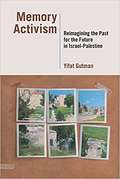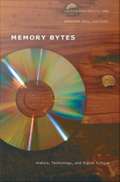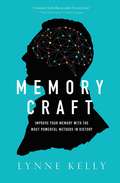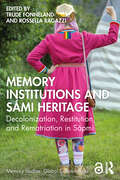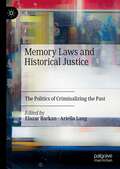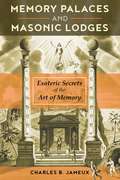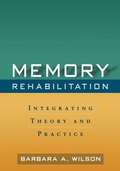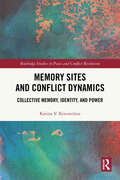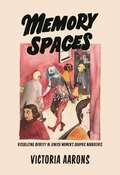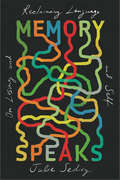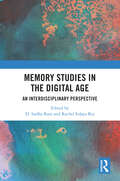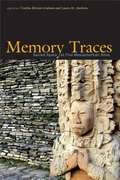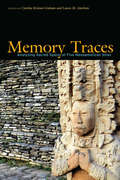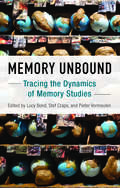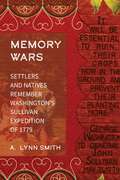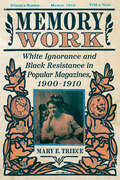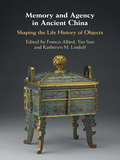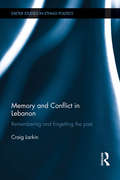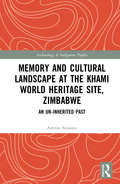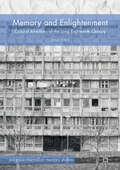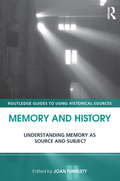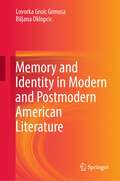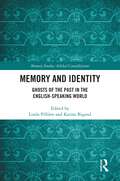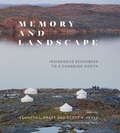- Table View
- List View
Memory Activism: Reimagining the Past for the Future in Israel-Palestine
by Yifat GutmanSet in Israel in the first decade of the twenty-first century and based on long-term fieldwork, this rich ethnographic study offers an innovative analysis of the Israeli-Palestinian conflict. It explores practices of "memory activism" by three groups of Jewish-Israeli and Arab-Palestinian citizens--Zochrot, Autobiography of a City, and Baladna--showing how they appropriated the global model of truth and reconciliation while utilizing local cultural practices such as tours and testimonies.These activist efforts gave visibility to a silenced Palestinian history in order to come to terms with the conflict's origins and envision a new resolution for the future. This unique focus on memory as a weapon of the weak reveals a surprising shift in awareness of Palestinian suffering among the Jewish majority of Israeli society in a decade of escalating violence and polarization--albeit not without a backlash.Contested memories saturate this society. The 1948 war is remembered as both Independence Day by Israelis and al-Nakba ("the catastrophe") by Palestinians. The walking tour and survivor testimonies originally deployed by the state for national Zionist education that marginalized Palestinian citizens are now being appropriated by activists for tours of pre-state Palestinian villages and testimonies by refugees.
Memory Activism: Reimagining the Past for the Future in Israel-Palestine
by Yifat GutmanSAGE Memory Studies Journal & Memory Studies Association Outstanding First Book Award, Honorable Mention, 2019 Set in Israel in the first decade of the twenty-first century and based on long-term fieldwork, this rich ethnographic study offers an innovative analysis of the Israeli-Palestinian conflict. It explores practices of "memory activism" by three groups of Jewish-Israeli and Arab-Palestinian citizens--Zochrot, Autobiography of a City, and Baladna--showing how they appropriated the global model of truth and reconciliation while utilizing local cultural practices such as tours and testimonies. These activist efforts gave visibility to a silenced Palestinian history in order to come to terms with the conflict's origins and envision a new resolution for the future. This unique focus on memory as a weapon of the weak reveals a surprising shift in awareness of Palestinian suffering among the Jewish majority of Israeli society in a decade of escalating violence and polarization--albeit not without a backlash. Contested memories saturate this society. The 1948 war is remembered as both Independence Day by Israelis and al-Nakba ("the catastrophe") by Palestinians. The walking tour and survivor testimonies originally deployed by the state for national Zionist education that marginalized Palestinian citizens are now being appropriated by activists for tours of pre-state Palestinian villages and testimonies by refugees.
Memory Bytes
by Lauren RabinovitzDigital culture is often characterized as radically breaking with past technologies, practices, and ideologies rather than as reflecting or incorporating them. Memory Bytes seeks to counter such ahistoricism, arguing for the need to understand digital culture--and its social, political, and ethical ramifications--in historical and philosophical context. Looking at a broad range of technologies, including photography, print and digital media, heat engines, stereographs, and medical imaging, the contributors present a number of different perspectives from which to reflect on the nature of media change. While foregrounding the challenges of drawing comparisons across varied media and eras, Memory Bytes explores how technologies have been integrated into society at different moments in time. These essays from scholars in the social sciences and humanities cover topics related to science and medicine, politics and war, mass communication, philosophy, film, photography, and art. Whether describing how the cultural and legal conflicts over player piano rolls prefigured controversies over the intellectual property status of digital technologies such as mp3 files; comparing the experiences of watching QuickTime movies to Joseph Cornell's "boxed relic" sculptures of the 1930s and 1940s; or calling for a critical history of electricity from the Enlightenment to the present, Memory Bytes investigates the interplay of technology and culture. It relates the Information Age to larger and older political and cultural phenomena, analyzes how sensory effects have been technologically produced over time, considers how human subjectivity has been shaped by machines, and emphasizes the dependence of particular technologies on the material circumstances within which they were developed and used. Contributors. Judith Babbitts, Scott Curtis, Ronald E. Day, David Depew, Abraham Geil, Sharon Ghamari-Tabrizi, Lisa Gitelman, N. Katherine Hayles, John Durham Peters, Lauren Rabinovitz, Laura Rigal, Vivian Sobchack, Thomas Swiss
Memory Craft: Improve Your Memory With The Most Powerful Methods In History--from Medieval Bestiaries To Tibetan Mandalas
by Lynne KellyGroundbreaking anthropologist and memory champion Lynne Kelly reveals how we can use ancient and traditional mnemonic methods to enhance and expand our memory. Our brain is a muscle. Like our bodies, it needs exercise. In the last few hundred years, we have stopped training our memories and we have lost the ability to memorize large amounts of information—something our ancestors could do with ease. After discovering that the true purpose of monuments like Easter Island and Stonehenge were to act as memory palaces, Kelly takes this knowledge and introduces us to the best memory techniques humans have ever devised, from ancient times and the Middle Ages to methods used by today’s memory athletes. A memory champion herself, Kelly tests all these methods and demonstrate the extraordinary capacity of our brains at any age. For anyone who needs to memorize a speech or a script, learn anatomy or a foreign language, or prepare for an exam, Memory Craft offers proven techniques and simple strategies for anyone who has trouble remembering names or dates, or for older people who want to keep their minds agile. In addition to getting in touch with our own human and anthropological foundations, Memory Craft shows how all things mnemonic can be playful, creative, and fun.
Memory Institutions and Sámi Heritage: Decolonization, Restitution, and Rematriation in Sápmi (Memory Studies: Global Constellations)
by Trude Fonneland Rossella RagazziWith a focus on Sápmi – the transcultural and transnational homeland of the Sámi people – this book presents case studies and theoretical frameworks which explore the ways in which memory institutions such as museums, archives, and festivals participate in and guide processes of appropriation, decolonization, and memory-making.The destruction and concealment of Sámi objects in both private and museum collections worldwide have impacted Sámi knowledge systems, disrupting local ways of knowing. Appreciation and reappropriation are important acts of decolonization which seek to create openings for reconnection to traditions, languages, and practices that were forcibly suppressed in the past. Western memory institutions such as museums, archives, and galleries have had a great impact on how heritage has been collected, stored, conserved, and organized within closed walls and glass cases. As the new museology movement developed in the 1990s, numerous examples revealed how difficult it became for researchers and public alike to access heritage. Considering the proliferation of cultural interventions and the growth of Sámi mobilization, which calls into question assumptions about how best to activate and experience Sámi cultural heritage and what constitutes appropriate stewardship, this book sheds light on initiatives to return artefacts to the Sámi community. With particular attention to the ways in which Sámi self-determination and the shifting boundaries between Indigenous and settler identities are articulated, challenged, and renegotiated, it draws on approaches from critical museology and Indigenous methodologies to explore the initiation, experience, and operationalizing of restitution projects.This book will therefore appeal to scholars of cultural studies, anthropology, sociology, and museum and heritage studies, as well as to those interested in questions of repatriation, restitution, and healing processes.
Memory Laws and Historical Justice: The Politics of Criminalizing the Past
by Elazar Barkan Ariella LangThis book examines state efforts to shape the public memory of past atrocities in the service of nationalist politics. This political engagement with the 'duty to remember', and the question of historical memory and identity politics, began as an effort to confront denialism with regard to the Holocaust, but now extends well beyond that framework, and has become a contentious subject in many countries. In exploring the politics of memory laws, a topic that has been overlooked in the largely legal analyses surrounding this phenomenon, this volume traces the spread of memory laws from their origins in Western Europe to their adoption by countries around the world. The work illustrates how memory laws have become a widespread tool of governments with a nationalist, majoritarian outlook. Indeed, as this volume illustrates, in countries that move from pluralism to majoritarianism, memory laws serve as a warning – a precursor to increasingly repressive, nationalist inclinations.
Memory Palaces and Masonic Lodges: Esoteric Secrets of the Art of Memory
by Charles B. JameuxReveals how the art of memory is the origin of the Masonic method • Explains the classical techniques of the art of memory, how they were reworked by hermetic thinkers during the Renaissance, and how they contributed to the transformation of operative Freemasonry into speculative Freemasonry • Traces the creation of speculative Freemasonry to 1637, one hundred years earlier than previously thought • Explores how the “memory palaces” created with the art of memory enabled access to universal knowledge as well as represented the Masonic temple in its imaginary state In Antiquity, the art of memory was a mnemonic device that allowed an orator, such as Cicero, to recall all the points he wished to make by associating each of them with an image or architectural element in the site he was speaking. When this art was rediscovered in the Renaissance, hermetic thinkers like Giordano Bruno reworked it into a method that allowed them to acquire knowledge with the creation of “memory palaces.” The elements of these memory palaces were not intended to trigger the memory but would actually transform into talismanic objects with knowledge entirely new to the seeker. In this book, Charles B. Jameux shows that this hermetic reworking of the classical art of memory was no mystery to operative Masons, who grafted it onto their own rituals, catalyzing the transformation of operative Masonry into speculative Masonry. He shows how the hieroglyphic writing used during the Renaissance in the art of memory provided the groundwork for one of the most esoteric elements of masonic practice: the grasp of the realm of image by the letter, where symbols were “buried” within words. Using archival evidence from 17th-century Scotland and earlier, combined with the research of modern scholars such as Frances Yates and David Stevenson, Jameux argues that the creation of speculative Freemasonry can be traced back 100 years earlier than conventional history records--to 1637, when the first recorded use of the Mason’s Word appeared and with it, the first known appearance of the symbolic Temple of Solomon. He follows Giordano Bruno’s visit to the British Isles in the late 16th century and the subsequent activities of the men he met there, showing that Masonic symbolism owes much of its current form to early memory palaces, which represented the Masonic lodge and temple in their fully imaginary states. Revealing the pivotal role of the memory palace and hermetic traditions in early Masonic symbolism, Jameux sheds new light on the Masonic questions asked of each initiate and the spiritual importance of the Temple of Jerusalem to Freemasonry.
Memory Rehabilitation
by Barbara WilsonFrom a well-known authority, this comprehensive yet accessible book shows how state-of-the-art research can be applied to help people with nonprogressive memory disorders improve their functioning and quality of life. Barbara Wilson describes a broad range of interventions, including compensatory aids, learning strategies, and techniques for managing associated anxiety and stress. She reviews the evidence base for each clinical strategy or tool and offers expert guidance on how to assess patients, set treatment goals, develop individualized rehabilitation programs, and conduct memory groups. The book also provides essential background knowledge on the nature and causes of memory impairment.
Memory Sites and Conflict Dynamics: Collective Memory, Identity, and Power (Routledge Studies in Peace and Conflict Resolution)
by Karina V. KorostelinaThis book explores the ways in which memory sites contribute to the dynamics of identity-based conflicts, fueling fears and sharpening divisions, or promoting commonalities and reducing violence.Through an analysis of the dynamics of identity-based conflicts, the book shows how memory sites become intertwined with the transformations of social boundaries and perceptions of relative deprivation, outgroup threat, collective axiology, and power relations. It posits that these two sets of factors – the functioning of collective memory as an ideological construct and the transformation of conflictual social relations – define the role and influence of memory sites in the dynamics of identity-based conflicts. Through multiple case studies representing different dynamics – dealing with fascist and communist pasts in Italy, post-colonial relations between South Korea and Japan, ethnic conflict in Kosovo, and tribal acknowledgment for Native American Nations – the book discusses how memory sites contribute to competition over ownership, fights for legitimacy, claims of entitlements, and negative portrayals of the Other. In doing so, it outlines four major functions of memory sites – enhancing, ascribing, interacting, and legitimizing – and shows how they contribute to and shape the structure and dynamics of conflict. Concentrating on the linkages between memory sites, violence prevention, and reconciliation, the book proposes solutions for promoting peace, including the focus on plurality of heritage, recognition of fluidity of meanings, and resistance to singular interpretations and manipulations by identity entrepreneurs. This volume will be of much interest to students of peace and conflict studies, memory studies, and International Relations in general.
Memory Spaces: Visualizing Identity in Jewish Women's Graphic Narratives
by Victoria AaronsAn exploration of the work of Jewish women graphic novelists and the intricate Jewish identity is complicated by gender, memory, generation, and place—that is, the emotional, geographical, and psychological spaces that women inhabit. Victoria Aarons argues that Jewish women graphic novelists are preoccupied with embodied memory: the way the body materializes memory. This monograph investigates how memory manifests in the drawn shape of the body as an expression of the weight of personal and collective histories. Aarons explores Jewish identity, diaspora, mourning, memory, and witness in the works of Sarah Lightman, Liana Finck, Anya Ulinich, Leela Corman, and more. Memory Spaces begins by framing this research within contemporary discourse and reflects upon the choice to explore Jewish women graphic novelists specifically. In the chapters that follow, Aarons relates the nuanced issues of memory, transmission of trauma, Jewish cultural identity, and the gendered self to a series of meaningful and noteworthy graphic novels. Aarons’s insight, close readings, and integration of contemporary scholarship are conveyed clearly and concisely, creating a work that both captivates readers and contributes to scholarly discourse in Jewish studies, women’s literature, memory studies, and identity.
Memory Speaks: On Losing and Reclaiming Language and Self
by Julie SedivyFrom an award-winning writer and linguist, a scientific and personal meditation on the phenomenon of language loss and the possibility of renewal. As a child Julie Sedivy left Czechoslovakia for Canada, and English soon took over her life. By early adulthood she spoke Czech rarely and badly, and when her father died unexpectedly, she lost not only a beloved parent but also her firmest point of connection to her native language. As Sedivy realized, more is at stake here than the loss of language: there is also the loss of identity. Language is an important part of adaptation to a new culture, and immigrants everywhere face pressure to assimilate. Recognizing this tension, Sedivy set out to understand the science of language loss and the potential for renewal. In Memory Speaks, she takes on the psychological and social world of multilingualism, exploring the human brain’s capacity to learn—and forget—languages at various stages of life. But while studies of multilingual experience provide resources for the teaching and preservation of languages, Sedivy finds that the challenges facing multilingual people are largely political. Countering the widespread view that linguistic pluralism splinters loyalties and communities, Sedivy argues that the struggle to remain connected to an ancestral language and culture is a site of common ground, as people from all backgrounds can recognize the crucial role of language in forming a sense of self. Distinctive and timely, Memory Speaks combines a rich body of psychological research with a moving story at once personal and universally resonant. As citizens debate the merits of bilingual education, as the world’s less dominant languages are driven to extinction, and as many people confront the pain of language loss, this is badly needed wisdom.
Memory Studies in the Digital Age: An Interdisciplinary Perspective
by D. Sudha Rani and Rachel Irdaya RajThis interdisciplinary volume attempts to gauge the individual and social issues related to memory, with an understanding of memory studies as an independent body of scholarship. It draws on multiple fields of knowledge, like popular culture, history, literature, oral cultures, and storytelling, which facilitates a panoramic view of memory studies.This book investigates the intersection between memory studies, partition, oral literature, and digital technology. It is also informed by the consciousness of memory in the digital age, which plays an integral role in what is remembered/forgotten, the form in which such memories are stored, and how they might be retrieved in future.This book will be an invaluable resource for those involved in research from undergraduate to post-doctoral level. This includes sociologists, psychologists, historians, artists, academicians, as well as research scholars from other disciplines.
Memory Traces
by Laura M. Amrhein Cynthia Kristan-Graham"In Memory Traces, art historians and archaeologists come together to examine the nature of sacred space in Mesoamerica. Through five well-known and important centers of political power and artistic invention in Mesoamerica--Tetitla at Teotihuacan, Tula Grande, the Mound of the Building Columns at El Tajín, the House of the Phalli at Chichén Itzá, and Tonina--contributors explore the process of recognizing and defining sacred space, how sacred spaces were viewed and used both physically and symbolically, and what theoretical approaches are most useful for art historians and archaeologists seeking to understand these places.Memory Traces acknowledges that the creation, use, abandonment, and reuse of sacred space has a strongly recursive relation to collective memory and meanings linked to the places in question, and reconciles issues of continuity and discontinuity of memory in ancient Mesoamerican sacred spaces. It will be of interest to students and scholars of Mesoamerican studies and material culture, art historians, architectural historians, and cultural anthropologists."
Memory Traces: Analyzing Sacred Space at Five Mesoamerican Sites
by Laura M. Amrhein Cynthia Kristan-GrahamIn Memory Traces, art historians and archaeologists come together to examine the nature of sacred space in Mesoamerica. Through five well-known and important centers of political power and artistic invention in Mesoamerica—Tetitla at Teotihuacan, Tula Grande, the Mound of the Building Columns at El Tajín, the House of the Phalli at Chichén Itzá, and Tonina—contributors explore the process of recognizing and defining sacred space, how sacred spaces were viewed and used both physically and symbolically, and what theoretical approaches are most useful for art historians and archaeologists seeking to understand these places. Memory Traces acknowledges that the creation, use, abandonment, and reuse of sacred space have a strongly recursive relation to collective memory and meanings linked to the places in question and reconciles issues of continuity and discontinuity of memory in ancient Mesoamerican sacred spaces. It will be of interest to students and scholars of Mesoamerican studies and material culture, art historians, architectural historians, and cultural anthropologists. Contributors: Laura M. Amrhein, Nicholas P. Dunning, Rex Koontz, Cynthia Kristan-Graham, Matthew G. Looper, Travis Nygard, Keith M. Prufer, Matthew H. Robb, Patricia J. Sarro, Kaylee Spencer, Eric Weaver, Linnea Wren
Memory Unbound: Tracing the Dynamics of Memory Studies
by Stef Craps Pieter Vermeulen Lucy BondThough still a relatively young field, memory studies has undergone significant transformations since it first coalesced as an area of inquiry. Increasingly, scholars understand memory to be a fluid, dynamic, unbound phenomenon-a process rather than a reified object. Embodying just such an elastic approach, this state-of-the-field collection systematically explores the transcultural, transgenerational, transmedial, and transdisciplinary dimensions of memory-four key dynamics that have sometimes been studied in isolation but never in such an integrated manner. Memory Unbound places leading researchers in conversation with emerging voices in the field to recast our understanding of memory's distinctive variability.
Memory Wars: Settlers and Natives Remember Washington's Sullivan Expedition of 1779
by A. Lynn SmithMemory Wars explores how commemorative sites and patriotic fanfare marking the mission of General John Sullivan into Iroquois territory during the Revolutionary War continue to shape historical understandings today. Sullivan&’s expedition was ordered by General George Washington at a tenuous moment of the Revolutionary War. It was a massive enterprise involving thousands of men who marched across northeastern Pennsylvania into what is now New York state, to eliminate any present or future threat from the British-allied Iroquois Confederacy. Sullivan and his men carried out a scorched-earth campaign, obliterating more than forty Iroquois villages, including homes, fields, and crops. For Indigenous residents it was a catastrophic invasion. For many others the expedition yielded untold bounty: American victory over the British along with land and fortunes beyond measure for settlers who soon moved onto the razed village sites. The Sullivan Expedition has long been fixed on the landscape of Pennsylvania and New York by a cast of characters, including amateur historians, newly formed historical societies, and local chapters of the Daughters of the American Revolution. Asking how it is that people continue to &“celebrate Sullivan&” in the present day, Memory Wars underscores the symbolic value of the past as well as the dilemmas posed to contemporary Americans by the national commemorative landscape.
Memory Work: White Ignorance and Black Resistance in Popular Magazines, 1900-1910 (Race, Rhetoric, and Media Series)
by Mary E. TrieceIn the early twentieth century, white-controlled magazines and Black magazines told very different stories about the dynamics of race, sex, and power in the United States. Memory Work: White Ignorance and Black Resistance in Popular Magazines, 1900–1910 examines how popular magazines employed rhetorical strategies to remember, forget, and frame America’s racist past. White-controlled magazines such as the Independent, Outlook, Arena, and McClure’s carried stories of southern nostalgia, union reconciliation, and white purity. Relying on willful ignorance to misremember past experiences of suffering, these texts severed violent histories from present-day policies and often simply remained silent. Meanwhile, in Black magazines such as the Colored American Magazine and the Voice of the Negro, women writers leveraged countermemory. Bringing Black women’s accomplishments into focus, these writers inverted popular white narratives that erased and obscured Black women’s experiences, including those of sexual violence. Mary E. Triece traces how white and Black magazines—often in dialogue with one another—differently engaged memory work to either reinforce or upend white supremacy during a period of both Black advancement and white backlash. Further, the book suggests lines of connection between the construction of public memory in the past to those taking place today across an array of media platforms. Popular debates—whether appearing in early 1900s magazines or on twenty-first-century social media sites—shape a culture’s collective knowledge of what counts as true, important, and worthy of attention.
Memory and Agency in Ancient China: Shaping the Life History of Objects
by Yan Sun Francis Allard Kathryn M. LinduffMemory and Agency in Ancient China offers a novel perspective on China's material culture. The volume explores the complex 'life histories' of selected objects, whose trajectories as ginle objects ('biographies') and object types ('lineages') cut across both temporal and physical space. The essays, written by a team of international scholars, analyse the objects in an effort to understand how they were shaped by the constraints of their social, political and aesthetic contexts, just as they were also guided by individual preference and capricious memory. They also demonstrate how objects were capable of effecting change. Ranging chronologically from the Neolithic to the present, and spatially from northern to southern mainland China and Taiwan, this book highlights the varied approaches that archaeologists and art historians use when attempting to reconstruct object trajectories. It also showcases the challenges they face, particularly with the unearthing of objects from archaeological contexts that, paradoxically, come to represent the earliest known point of their 'post-recovery lives'.
Memory and Conflict in Lebanon: Remembering and Forgetting the Past (Exeter Studies in Ethno Politics)
by Craig LarkinThis book examines the legacy of Lebanon’s civil war and how the population, and the youth in particular, are dealing with their national past. Drawing on extensive qualitative research and social observation, the author explores the efforts of those who wish to remember, so as not to repeat past mistakes, and those who wish to forget. In considering how the Lebanese youth are negotiating this collective memory, Larkin addresses issues of: Lebanese post-war amnesia and the gradual emergence of new memory discourses and public debates Lebanese nationalism and historical memory visual memory and mnemonic landscapes oral memory and post-war narratives war memory as an agent of ethnic conflict and a tool for reconciliation and peace-building. trans-generational trauma or postmemory. Shedding new light on trauma and the persistence of ethnic and religious hostility, this book offers a unique insight into Lebanon’s recurring communal tensions and a fresh perspective on the issue of war memory. As such, this is an essential addition to the existing literature on Lebanon and will be relevant for scholars of sociology, Middle East studies, anthropology, politics and history.
Memory and Cultural Landscape at the Khami World Heritage Site, Zimbabwe: An Un-inherited Past (Archaeology & Indigenous Peoples)
by Ashton SinamaiThis book focuses on a forgotten place—the Khami World Heritage site in Zimbabwe. It examines how professionally ascribed values and conservation priorities affect the cultural landscape when there is a disjuncture between local community and national interests, and explores the epistemic violence that often accompanied colonial heritage management and archaeology in southern Africa. The central premise is that the history of the modern Zimbabwe nation, in terms of what is officially remembered and celebrated, inevitably determines how that past is managed. It is about how places are experienced and remembered through narratives and how the loss of this heritage memory may mark the un-inheriting of place. Memory and Cultural Landscape at the Khami World Heritage Site, Zimbabwe is informed by the author’s experience of living near and working at Great Zimbabwe and Khami as an archaeologist, and uses archives and traditional narratives to build a biography for this lost cultural landscape. Whereas Great Zimbabwe is a resource for the state’s contentious narrative of unity, and a tool for cultural activism among communities whose cultural rights are denied through the nationalisation and globalisation heritage, at Khami, which has lost its historical gravity, there is only silence. Researchers and students of cultural heritage will find this book a much-needed case study on heritage, identity, community and landscape from an African perspective.
Memory and Enlightenment: Cultural Afterlives of the Long Eighteenth Century (Palgrave Macmillan Memory Studies)
by James WardThis book illuminates how the ‘long eighteenth century’ (1660-1800) persists in our present through screen and performance media, writing and visual art. Tracing the afterlives of the period from the 1980s to the present, it argues that these emerging and changing forms stage the period as a point of origin for the grounding of individual identity in personal memory, and as a site of foundational traumas that shape cultural memory.
Memory and History: Understanding Memory as Source and Subject (Routledge Guides to Using Historical Sources)
by Joan TumbletyHow does the historian approach memory and how do historians use different sources to analyze how history and memory interact and impact on each other? Memory and History explores the different aspects of the study of this field. Taking examples from Europe, Australia, the USA and Japan and treating periods beyond living memory as well as the recent past, the volume highlights the contours of the current vogue for memory among historians while demonstrating the diversity and imagination of the field. Each chapter looks at a set of key historical and historiographical questions through research-based case studies: How does engaging with memory as either source or subject help to illuminate the past? What are the theoretical, ethical and/or methodological challenges that are encountered by historians engaging with memory in this way, and how might they be managed? How can the reading of a particular set of sources illuminate both of these questions? The chapters cover a diverse range of approaches and subjects including oral history, memorialization and commemoration, visual cultures and photography, autobiographical fiction, material culture, ethnic relations, the individual and collective memories of war veterans. The chapters collectively address a wide range of primary source material beyond oral testimony – photography, monuments, memoir and autobiographical writing, fiction, art and woodcuttings, ‘everyday’ and ‘exotic’ cultural artefacts, journalism, political polemic, the law and witness testimony. This book will be essential reading for students of history and memory, providing an accessible guide to the historical study of memory through a focus on varied source materials.
Memory and Identity in Modern and Postmodern American Literature
by Biljana Oklopcic Lovorka Gruic GrmusaThis book discusses how American literary modernism and postmodernism interconnect memory and identity and if, and how, the intertwining of memory and identity has been related to the dominant socio-cultural trends in the United States or the specific historical contexts in the world. The book’s opening chapter is the interrogation of the narrator’s memories of Jay Gatsby and his life in F. Scott Fitzgerald’s The Great Gatsby. The second chapter shows how in William Faulkner’s Light in August memory impacts the search for identities in the storylines of the characters. The third chapter discusses the correlation between memory, self, and culture in Tennessee Williams’s A Streetcar Named Desire. Discussing Robert Coover’s Gerald’s Party, the fourth chapter reveals that memory and identity are contextualized and that cognitive processes, including memory, are grounded in the body’s interaction with the environment, featuring dehumanized characters, whose identities appear as role-plays. The subsequent chapter is the analysis of how Jonathan Safran Foer’s Everything Is Illuminated deals with the heritage of Holocaust memories and postmemories. The last chapter focuses on Thomas Pynchon’s Against the Day, the reconstructive nature of memory, and the politics and production of identity in Southeastern Europe.
Memory and Identity: Ghosts of the Past in the English-speaking World (Memory Studies: Global Constellations)
by Linda Pillière Karine BigandThis book examines the ways in which ghosts haunt and shape cultural identities and memory, considering the manner in which the fluctuations of such identities sometimes imply the rethinking or rewriting of the past. Drawing on case studies in historical, political, literary and linguistic studies, it explores the narratives that produce imagined communities and identities and the places in which cultural identities are constructed through memory, asking how far these identities and memories disinherit or exclude otherness, and how far ghosts disturb orderly narratives, inviting multiple readings of the past. Thematically organized to consider the persistence of ghosts within present memory and identity, the creation of new identities through intertwining narratives of the past, and the reclamation of identities in postcolonial contexts, Memory and Identity: Ghosts of the past in the English-speaking world offers a multi-disciplinary examination of the concept of haunting. Memory and Identity will appeal to scholars of sociology, anthropology, cultural studies and history with interests in memory and identity.
Memory and Landscape: Indigenous Responses to a Changing North
by Scott A. Heyes Kenneth L. PrattThe North is changing at an unprecedented rate as industrial development and the climate crisis disrupt not only the environment but also long-standing relationships to the land and traditional means of livelihood. Memory and Landscape: Indigenous Responses to a Changing North explores the ways in which Indigenous peoples in the Arctic have adapted to challenging circumstances, including past cultural and environmental changes. In this beautifully illustrated volume, contributors document how Indigenous communities in Alaska, northern Canada, Greenland, and Siberia are seeking ways to maintain and strengthen their cultural identity while also embracing forces of disruption. Indigenous and non-Indigenous contributors bring together oral history and scholarly research from disciplines such as linguistics, archaeology, and ethnohistory. With an emphasis on Indigenous place names, this volume illuminates how the land—and the memories that are inextricably tied to it—continue to define Indigenous identity. The perspectives presented here also serve to underscore the value of Indigenous knowledge and its essential place in future studies of the Arctic. Contributions by Vinnie Baron, Hugh Brody, Kenneth Buck, Anna Bunce, Donald Butler, Michael A. Chenlov, Aron L. Crowell, Peter C. Dawson, Martha Dowsley, Robert Drozda, Gary Holton, Colleen Hughes, Peter Jacobs, Emily Kearney-Williams, Igor Krupnik, Apayo Moore, Murielle Nagy, Mark Nuttall, Evon Peter, Louann Rank, William E. Simeone, Felix St-Aubin, and Will Stolz.
